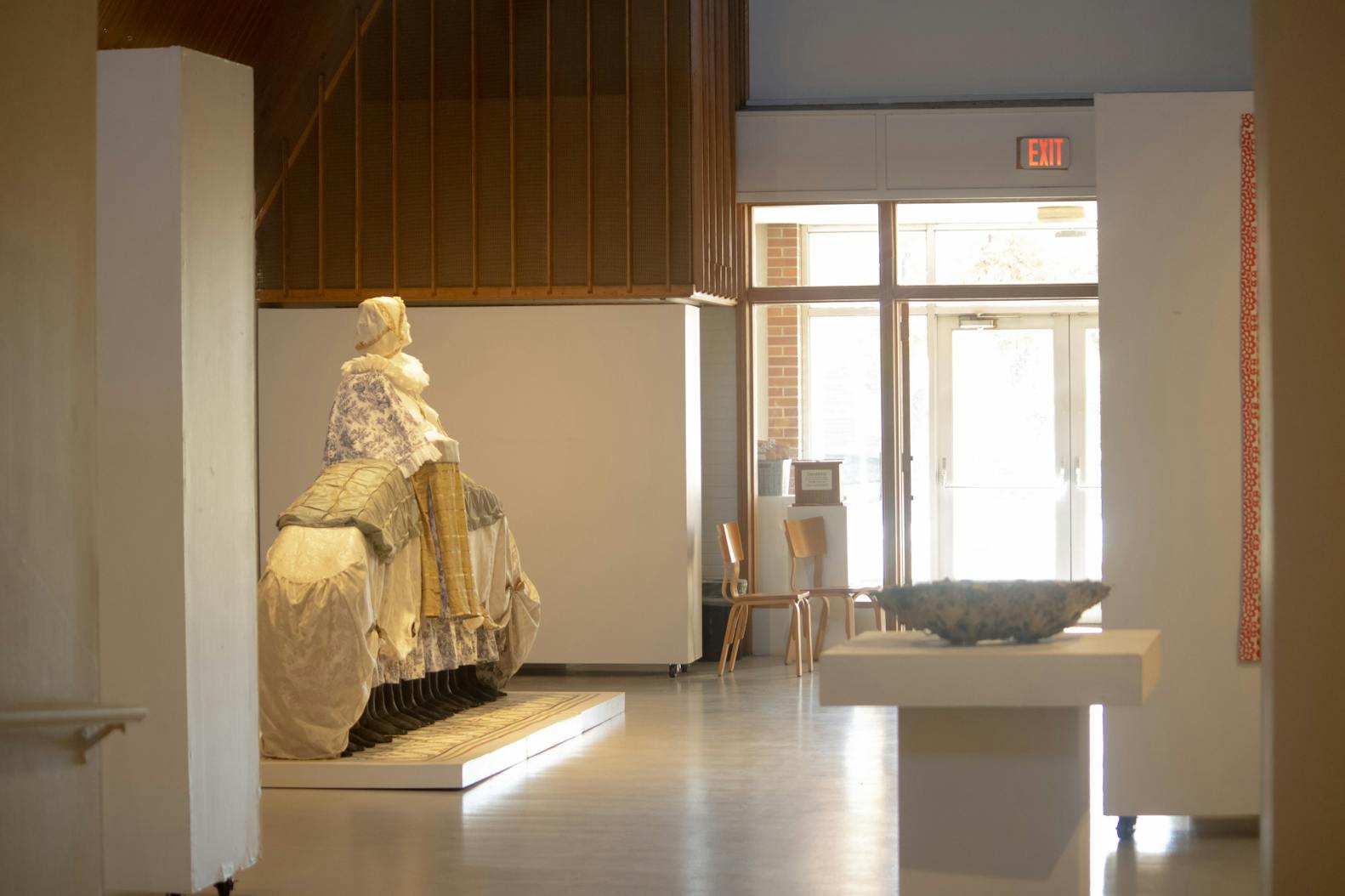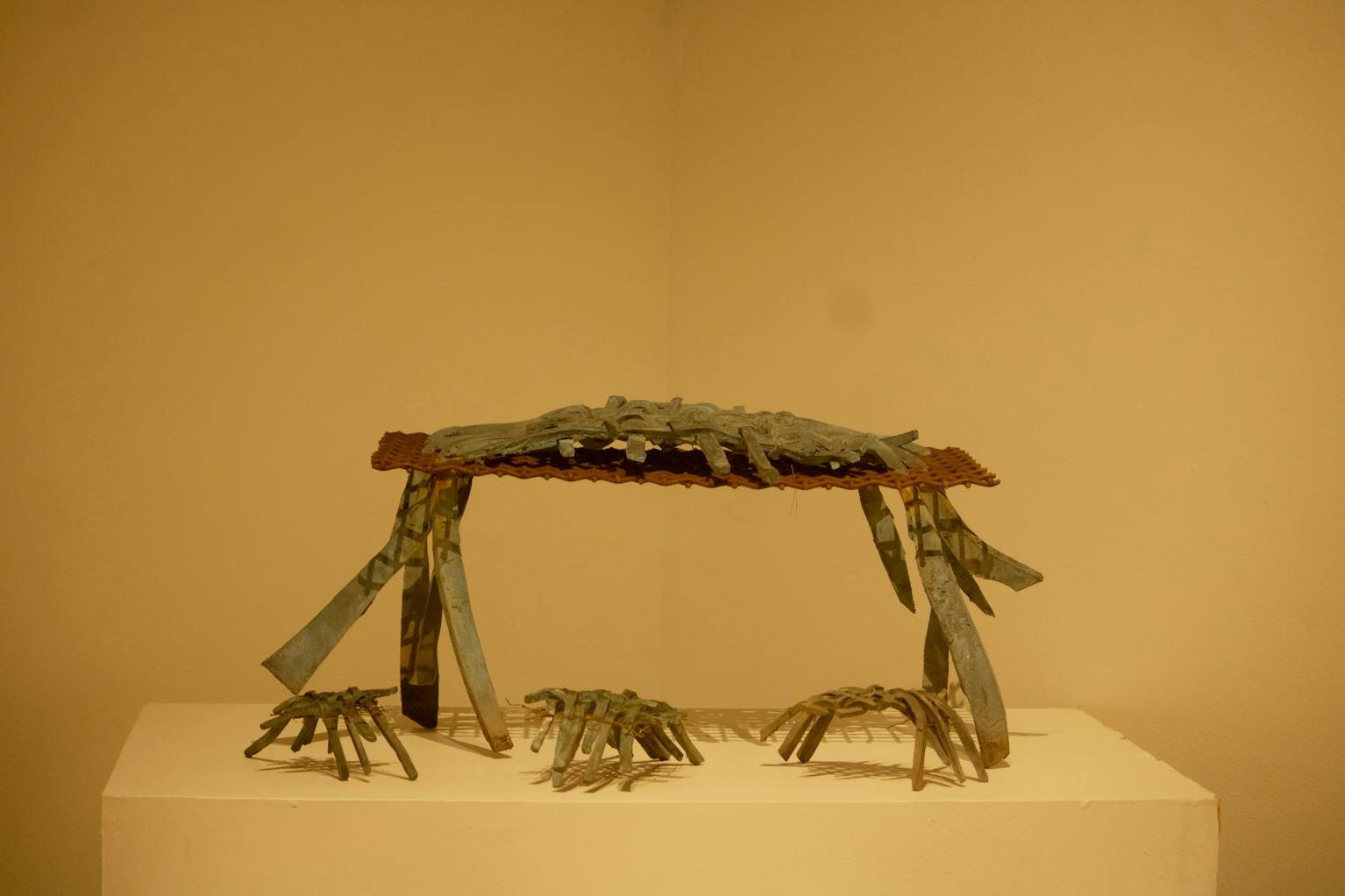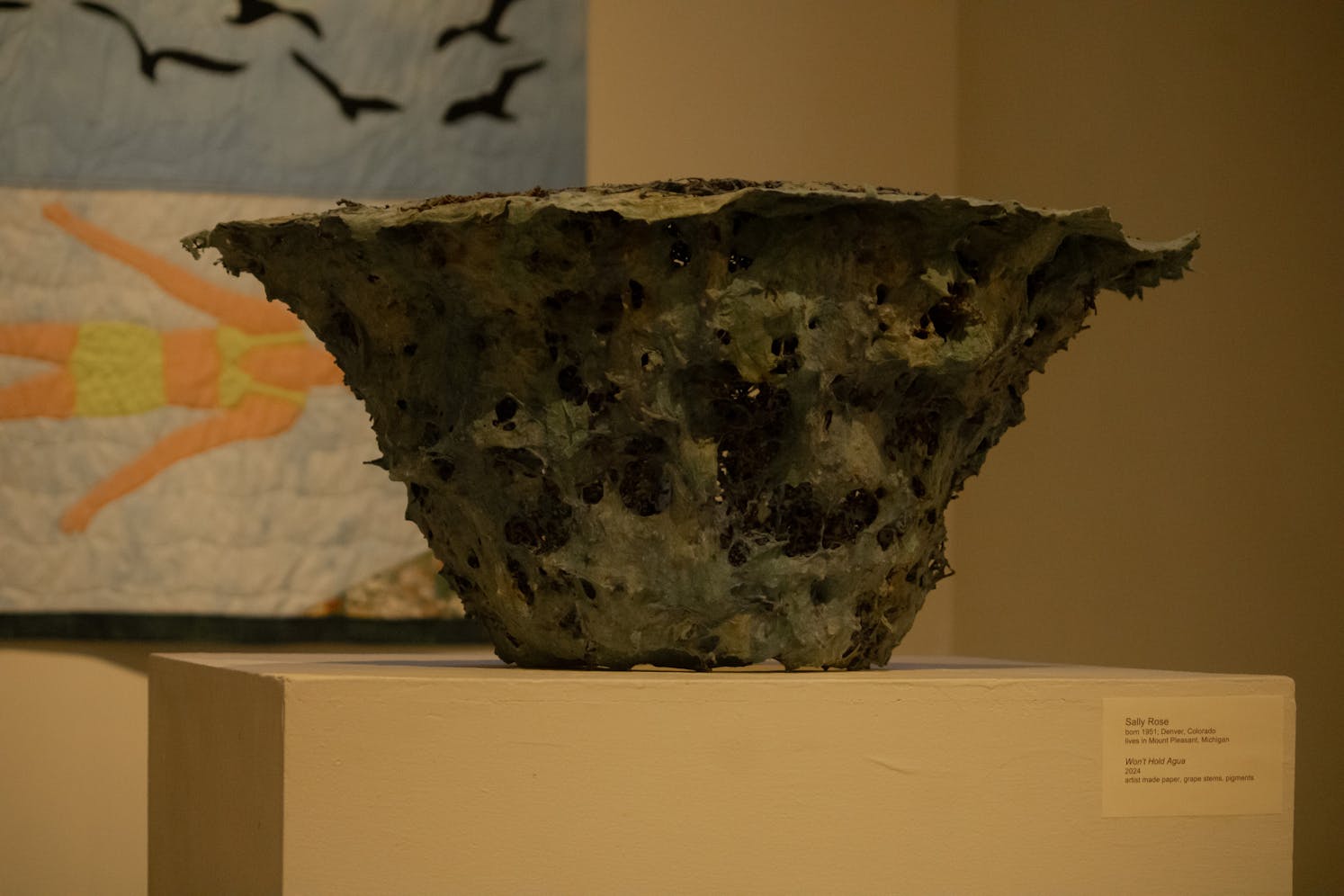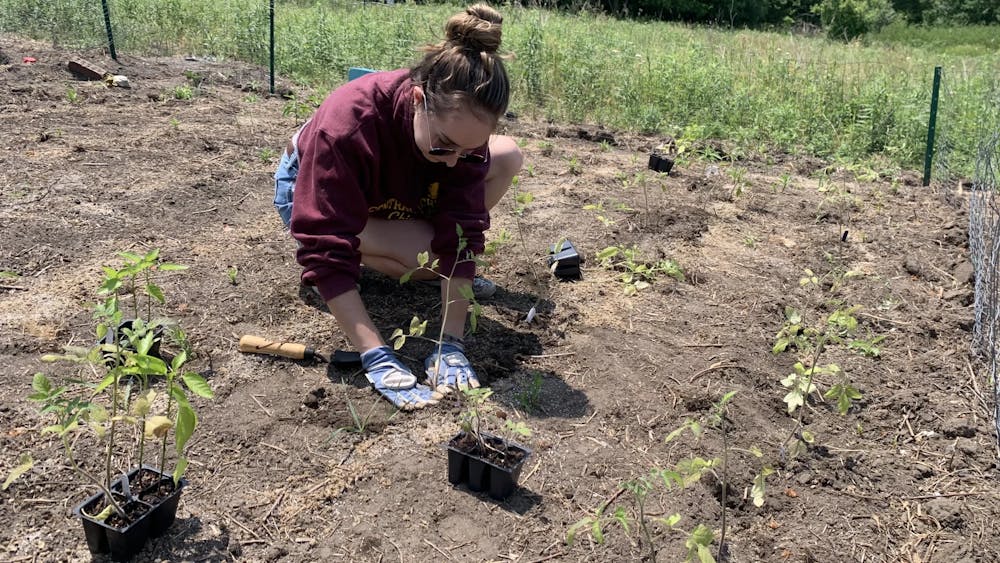Pushing the boundaries
University Art Gallery exhibition Pushing Fiber showcases the evolving nature of art

From laundry baskets and garden plants to a weave of fibers and cordage water-falling down the back wall of the University Art Gallery to sparkling figures catching your eye as the sun reflects off beads, the Pushing Fiber art exhibit extends the boundaries of creation and establishes fibers’ purpose in contemporary art, said Anne Gochenour.
Gochenour, the University Art Gallery director, said the exhibit is about variety and new forms of art.
“The exhibition is about really pushing the parameters of what people think art is,” Gochenour said. “That’s what has been going on in the last 30 or 40 years in the field of art and with fiber specifically.”
According to the Central Michigan University Art Gallery website, the gallery’s mission is to provide community members with the opportunity and experience of seeing contemporary art done by a variety of artists: local, regional and international.
Gochenour said for this specific exhibit, she was trying to gather a variety of fiber work that she thought pushed the confines of contemporary art.
Denise Fanning, the art coordinator in the Park Library and gallery director of the Baber Room Gallery, said she’s not a traditional fiber artist and often uses many different materials.
“I work with whatever material the idea demands and that often comes in the form of fiber,” Fanning said. “So because I work with a lot of natural materials, I work with what is available to me without necessarily adding to the (environmental) footprint.”

Fiber art and the feminist movement
According to ATX Fine Arts, fiber art utilizes natural and synthetic fibers to create a range of textiles and woven items.
ATX Fine Arts states on their website that, “This genre of art is rooted in traditional techniques, such as weaving, knitting, and embroidery, but it has expanded to include contemporary approaches and innovative techniques.”
Fanning said the fibers she works with requires a depth of care and intention such as growing, harvesting, drying and weaving it back into her work.
“There are many layers of care and tending,” she said. “To me, it's an act of nurturing.”
Fanning said a lot of fiber arts come from the hands of women and are made with an act of care, such as stitching to make clothes or harvesting sheep wool to turn into yarn.
“The act of making work with fiber tends to be stereotypically and historically women’s work,” she said. “So there is this quality of tending and nurturing that comes along with it.”
Gochenour said the Feminist art movement in the 1960s and 1970s brought fiber craft to life.
“That craft was usually women made, and we should recognize that by opening up the art world to include that,” Gochenour said.
According to ATX Fine Arts, women artists during that time period turned to fiber art as a way to explore gender, identity and the domestic sphere as a result of the feminist movement.

Cloaks and pillows
Fanning currently has two pieces in the gallery: "The Good Mother Cloak" and "A Soft Place to Land (Rest in Peace)".
The cloak is a wearable garment made up of deconstructed laundry baskets, cordage from her garden plants, birds’ nests and embroidery thread. The other exhibit is located in the corners of the room made from recycled down comforter, beeswax, cordage, grass, moss and natural remains such as bones.
Fanning said she feels both pieces are special in their own way because they were both years in the making and felt they had a purpose.
“For me, when I get that epiphany click, it starts to make sense as to why I’ve been holding on to these things for all that time," she said. “That is where the magic happens.”
Fanning said many of the pieces used in her art are connected to an experience or memory.
“They hold their own whole lifetime of experience and memory inside them,” she said. “It feels like both these pieces are the truest representation of my interior and extensions of who I am.”
The process of creating "The Good Mother Cloak" helped her find the meaning and symbolism in several ways, she said.
“It’s slow, meditative work that allows me to keep my hands and mind busy while also keeping me open to receiving and thinking through the process,” she said. “I’m able to really think through the process of what it is I’m doing, why I’m saying what I’m saying and what it means.”
Fanning said from working on previous projects in her Good Mother series, she started thinking about what it means to be a good mother, a good human and what the word ‘good’ really means.
It can be challenging being a mother, an artist and a person who works, Fanning said, because it requires more prioritization of your schedule.
“In order to make time in the studio, I have to make the priority of working on my art rather than get the laundry folded and vice versa,” she said. “I had to force time in the studio because it didn’t exist.”
Fanning said there are all sorts of societal standards for what it means to be a present and a “good mom." She said she tried to be all the things that make up society's views of a “good mom” such as being present, accomplished and perfect.
“For a long time, I felt like I was being a bad mom if I chose to spend time in the studio,” Fanning said. “At some point though, I realized the better mom is showing my kids who I am and being an example of the fullest version of myself.
"I use the tools of voice and expression to show my commitment and dedication it takes to bring something like this to fruition outside of an already busy life,” she said.
The second piece Fanning brought to the exhibit is titled 'A Soft Place to Land (Rest in Peace)'. She said the objects found in this piece are all found in nature. The objects include animal remains, insects, nests, shells and other.
“I’m always looking for things that don’t blend in with its environment,” she said. “Therefore, I see and find a lot of things that might otherwise get lost in the leaf flutter on the ground.”
Fanning said she has always collected things she feels has a material identity or story trapped within it and wanted to give the objects another life.
“Some of it isn’t all that remarkable," she said. "But I like the juxtaposition of the unremarkable things next to the remarkable things."

Beaded figures
Mimi Holmes is a fiber artist from Minneapolis who did her graduate schooling at Florida State University.
Holmes came up with the idea for her pieces in the exhibit by seeing a little package of Mayan worry dolls.
According to From the Mayan, worry dolls were used in Mayan tradition to ease anxiety and stress for children that often had nightmares or couldn’t sleep.
“Before bed is ideally when a child confesses their fears, sorrows, and worries to the doll," the website reads. "They whisper their problems, then tuck the doll under the pillow. While the child is asleep, the doll does all the worrying, thus relieving the little one of all the concerns that would otherwise keep them from sleeping soundly.”
Holmes said as an adult, she felt she could use the tradition as a construct for her dolls to ease problems, worries or fears she encountered. Holmes often uses sequenced slugs to represent herself.
“I created these because of a worry I had from a fear of spreading disease and opening old wounds,” Holmes said. “I learned a friend of mine had HIV (Human Immunodeficiency Virus) which caused me a lot of worry … so I made the piece to deal with that.”
Holmes said another piece titled "Migrating Flesh" was created to cope with the worry and fear of getting older.
“You can’t control your body totally, once you get older," she said. "You start seeing little muffin tops or bulges start to appear which goes to the concept of women being constrained by society. We (women) were always told to appear picture perfect, have a healthy body, done up hair and to put on a good face.”
Holmes said the piece was about escaping.
“Even though you try to put on a good mask for the world, imperfections are there,” she said.
Homes said she was fascinated with looking at art from other cultures that would make objects to contain something such as fear.
“I looked at other cultures and how they dealt with things so I kind of made up my own coping mechanisms,” she said.
Holmes has sold 300 pieces of her work in Minneapolis. Her other works for sale can be found on Facebook Marketplace under her profile name: Mimi Holmes.
Exhibit artists
Gochenour said a unique thing about this show is that three of the artists are local and all are Midwesterners.
“A lot of times, the art world is centered around New York or Los Angeles, but there's actually very good artists and art being made in the midwest,” she said. “Although we're a little town, we've got some excellent artists.”
Fanning and Holmes along with four other artists have taken part in creating the Pushing Fiber art exhibit. The other artists are Ann Kowaleski, Tom Lundberg, Joey Quinones and Sally Rose.
The three local artists are Fanning, Rose and Kowaleski. Holmes is from Minneapolis, Minnesota, Quinones is currently in Detroit and Lundberg lives in Fort Collins, Colorado.
Gochenour said she was fortunate to work with installation artists such as Quinones.
“It’s nice to give artists the chance to install because that’s part of the art,” Gochenour said.
Gochenour said she anticipates that the exhibit expands the visitors' concept of art.
“I hope it brings some new experience to people, some joy and also some questioning because there’s some political content to the work,” she said.
Joining the six artists is barstow artist-in-resident, Katie Mongoven. She will be demonstrating the art of weaving and, with her assistance, give visitors a chance to try weaving in the west gallery of the University Art Gallery during the exhibit.
Mongoven will be in the gallery Wednesdays and Thursdays from 4 p.m. to 6 p.m. except on Oct. 31 and Fridays from 2 p.m. to 4 p.m.
The University Art Gallery will host an artist talk at 5 p.m. on Nov. 7 in the gallery. The talk will consist of presentations from three artists: Fanning, Rose and Kowaleski.



